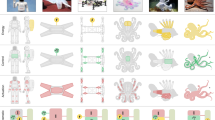Abstract
Life-like adaptive behaviour is so far an illusive goal in robot control. A capability to act successfully in a complex, ambiguous, and harsh environment would vastly increase the application domain of robotic devices. Established methods for robot control run up against a complexity barrier, yet living organisms amply demonstrate that this barrier is not a fundamental limitation. To gain an understanding of how the nimble behaviour of organisms can be duplicated in made-for-purpose devices we are exploring the use of biological cells in robot control. This paper describes an experimental setup that interfaces an amoeboid plasmodium of Physarum polycephalum with an omnidirectional hexapod robot to realise an interaction loop between environment and plasticity in control. Through this bio-electronic hybrid architecture the continuous negotiation process between local intracellular reconfiguration on the micro-physical scale and global behaviour of the cell in a macroscale environment can be studied in a device setting.
Preview
Unable to display preview. Download preview PDF.
Similar content being viewed by others
References
Lettvin, J.Y., Maturana, H.R., McCulloch, W.S., Pitts, W.H.: What the frog’s eye tells the frog’s brain. Proc. Inst. Radio Engr. 47, 1940–1951 (1959); Reprinted in: Corning, W.C., Balaban, M. (eds.): The Mind: Biological Approaches to its Functions, pp. 233–258 (1968) 1968, .
Braitenberg, V.: Experiments in Synthetic Psychology. MIT Press, Cambridge (1984)
Webb, B.: View from the boundary. Biological Bulletin 200(2), 184–189 (2001)
Hasslacher, B., Tilden, M.W.: Living machines. Robotics and Autonomous Systems, 143–169 (1995)
Beer, R.D.: Intelligence as Adaptive Behavior, an Experiment in Computational Neuroethology. Academic Press, London (1990)
Chiel, H.J., Beer, R.D.: The brain has a body: adaptive behavior emerges from interaction of nervous system, body and environment. Trends In Neuroscience 12, 553–557 (1997)
Maturana, H.R., Varela, F.J.: Autopoiesis and Cognition: The Realization of the Living. Boston Studies in the Philosophy of Science, vol. 42. D. Reidel Publishing, Dordecht (1980)
Cariani, P.: Some epistemological implications of devices which construct their own sensors and effectors. In: Varela, F.J., Bourgine, P. (eds.) Toward a Practice of Autonomous Systems: Proceedings of the First European Conference on Artificial Life, pp. 484–493. MIT Press, Cambridge (1992)
Chapin, J.K., Moxon, K.A., Markowitz, R.S., Nicolelis, M.A.L.: Real-time control of a robot arm using simultaneously recorded neurons in the motor cortex. Nature neuroscience 2(7), 664–670 (1999)
DeMarse, T.B., Wagenaar, D.A., Blau, A.W., Potter, S.M.: The neurally controlled animat: Biological brains acting with simulated bodies. Autonomous Robots 11, 305–310 (2001)
Rinaldo, K.: Augmented fish reality. ARS Electronica Center, Linz (2004), See also: http://accad.osu.edu/~rinaldo/works/augmented/
Adler, J., Tso, W.-W.: “Decision”-making in bacteria: Chemotactic response of Escherichia coli to conflicting stimuli. Science 184, 1292–1294 (1974)
Zauner, K.-P.: Molecular information technology. Critical Reviews in Solid State and Material Sciences 30(1), 33–69 (2005)
Rothstein, J.: Information, measurement, and quantum mechanics (1951); Reprinted in: H. S. Leff and A. F. Rex (Eds.): Maxwell’s Demon—Entropy, Information, Computing, pp. 104–108. Adam Hilger, Bristol (1990)
Skoultchi, A.I., Morowitz, H.J.: Information storage and survival of biological systems at temperatures near absolute zero. Yale J. Biol. Med. 37, 158–163 (1964)
Kondo, H., Yamamoto, M., Watanabe, M.: Reversible intracellular displacement of the cytoskeletal protein and organelles by ultracentrifugation of the sympathetic ganglion. J. Submicrosc. Cytol. Pathol. 24, 241–250 (1992)
Conrad, M.: The price of programmability. The Universal Turing Machine: A Half-Century Survey, 285–307 (1988)
Korohoda, W., Rakoczy, L., Walczak, T.: On the control mechanism of protoplasmic streamings in the plasmodia of Myxomycetes. Acta Protozoologica VII(29), 363–373 (1970)
Ueda, T., Matsumoto, K., Kobatake, Y.: Spatial and temporal organization of intracellular adenine nucleotides and cyclic nucleotides in relation to rhythmic motility in physarum plasmodium. Experimental Cell Research 162(2), 486–494 (1986)
Durham, A.C.H., Ridgway, E.B.: Control of chemotaxis in physarum polycephalum. The Journal of Cell Biology 69, 218–223 (1976)
Miura, H., Yano, M.: A model of organization of size invariant positional information in taxis of physarum plasmodium. Progress of Theoretical Physics 100(2), 235–251 (1998)
Miyake, Y., Tabata, S., Murakami, H., Yano, M., Shimizu, H.: Environmental-dependent self-organization of positional information field in chemotaxis of physarum plasmodium. Journal of Theoretical Biology 178, 341–353 (1996)
Nakagaki, T., Yamada, H., Toth, A.: Intelligence: Maze-solving by an amoeboid organism. Nature 407, 470 (2000)
Nakagaki, T., Kobayashi, R., Nishiura, Y., Ueda, T.: Obtaining multiple separate food sources: behavioural intelligence in the physarum plasmodium. R. Soc. Proc.: Biol. Sci. 271(1554), 2305–2310 (2004)
Aono, M.: Personal communication (2004)
Tsuda, S., Aono, M., Gunji, Y.-P.: Robust and emergent physarum logical-computing. BioSystems 73, 45–55 (2004)
Zauner, K.-P.: From prescriptive programming of solid-state devices to orchestrated self-organisation of informed matter. In: Banâtre, J.-P., Fradet, P., Giavitto, J.-L., Michel, O. (eds.) UPP 2004. LNCS, vol. 3566, pp. 47–55. Springer, Heidelberg (2005)
Takamtsu, A., Fujii, T., Endo, I.: Control of interaction strength in a network of the true slime mold by a microfabricated structure. BioSystems 55, 33–38 (2000)
Nomura, S.: Symbolization of an object and its freedom in biological systems. PhD thesis, Kobe University (2001)
Ueda, T., Mori, Y., Nakagaki, T., Kobatake, Y.: Action spectra for superoxide generation and UV and visible light photoavoidance in plasmodia of physarum polycephalum. Photochemistry and Photobiology 48, 705–709 (1988)
Conrad, M.: Emergent computation through self-assembly. Nanobiology 2, 5–30 (1993)
Gunji, Y.-P., Takahashi, T., Aono, M.: Dynamical infomorphism: form of endo-perspective. Chaos, Solitons and Fractals 22, 1077–1101 (2004)
Author information
Authors and Affiliations
Editor information
Editors and Affiliations
Rights and permissions
Copyright information
© 2006 Springer-Verlag Berlin Heidelberg
About this paper
Cite this paper
Tsuda, S., Zauner, KP., Gunji, YP. (2006). Robot Control: From Silicon Circuitry to Cells. In: Ijspeert, A.J., Masuzawa, T., Kusumoto, S. (eds) Biologically Inspired Approaches to Advanced Information Technology. BioADIT 2006. Lecture Notes in Computer Science, vol 3853. Springer, Berlin, Heidelberg. https://doi.org/10.1007/11613022_5
Download citation
DOI: https://doi.org/10.1007/11613022_5
Publisher Name: Springer, Berlin, Heidelberg
Print ISBN: 978-3-540-31253-6
Online ISBN: 978-3-540-32438-6
eBook Packages: Computer ScienceComputer Science (R0)




